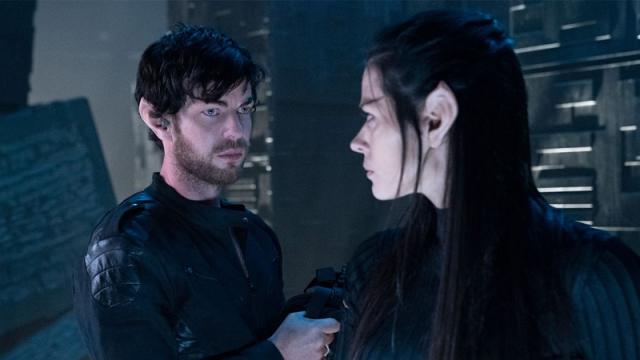Star Trek: Picard presented the first chance to explore what the franchise’s “contemporary” post-Nemesis timeline actually looked like. It delved into the ramifications of a galaxy shook by the devastating implosion of the Romulan Empire and the loss of its homeworlds. But for all the Romulan intrigue, Picard’s showrunner apparently had much, much more to share.
Michael Chabon — who’s no stranger to dispensing information about the background and workings of Picard outside of the show itself — took to Medium last night to pen an essay titled “Some Notes on Romulans, Condensed from various SI (Starfleet Intelligence) analyses, accuracy unknown.” What followed is a just-over 2,000-word essay that dives into the inner workings of Romulan society at large in a fascinating level of detail. He covers everything from Romulan spiritualism — and its absorption by the Imperial Family into a monolithic leader-worship system — to the history of its art. There are details on factions within the writhing Romulan leadership system that covers everything from its labyrinthine federal system to the Tal Shiar and the Qowat Milat (the antithetical, female-led mercenary order introduced in Picard and seen in Discovery’s third season).
It’s all fascinating world-building, and of course, because it’s the Romulans, it’s all about how masks and deception are deeply ingrained in their society to an almost excruciating level. And yes, that includes Romulan romance, apparently. According to Chabon’s notes, the height of Romulan love is not passion itself, but in the revealing of truth: most specifically, the intimacy of allowing someone outside of your immediate familial unit to know your “true name,” one of four given to a Romulan child at birth.
Chabon details both how Romulus’ stratified societal hierarchy allows individuals a surprising level of expressive social freedom when it comes to gender and sexual identity — and extra-marital polyamory — and how matrimony is…a three-way truth contract more than it is necessarily an act of love? “Romulan intimacy and erotics are centered around exchanges of truths, revealing of secrets, and the ultimate commitment of revealing your ‘inmost name’ to the other,” Chabon writes. “The term for the Romulan wedding ceremony roughly translates as ‘A Terror and a Name,’ a profoundly secretive ceremony (no guests are invited), in which each of the three (yes) partners reveals their inmost name and deepest fear to the other two.”
He continues, “Romulan ‘marriages’ (the word translates as ‘trust bond’) are always threesomes (in any configuration of genders) because at every moment each partner in the marriage serves as Verificator to the other two (in Romulan the verb ‘to verify’ is related to verbs meaning. ‘to police’ and ‘to monitor’), verifying the trust bond of the two others, who are known by a Romulan word that literally translates as ‘conspirators.’ In practice the threesome may or may not cohabit/reproduce — there is great variability here.”
It’s hard to tell how much of this is meant to be taken as either Chabon’s own creative pontification, flowery-but-unimportant background detail used to inform Picard’s worldbuilding, or something actually established within Star Trek’s vast canon. After all, an off-the-cuff medium post seems like a pretty odd place to drop what is a fundamental exploration of Romulan society and culture in a level Star Trek has barely managed to touch on in past stories with them.
But it’s still fascinating to see just what makes one of Trek’s most secretive societies tick — and frankly, there are few things more Romulan than feeling like you’re having an overwhelming amount of information revealed to you, only to be equally unsure if any of it happens to actually be true.
